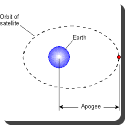 The apogee is the point at which a body is at its furthest orbit from the Earth. The opposite of the apogee, the point at which an orbiting body is nearest to the earth, is the perigee. Apogee is an Earth-specific term, and other terms exist for different celestial bodies.
The apogee is the point at which a body is at its furthest orbit from the Earth. The opposite of the apogee, the point at which an orbiting body is nearest to the earth, is the perigee. Apogee is an Earth-specific term, and other terms exist for different celestial bodies.
The apsis, for example, is a generic term used to describe the point at which an orbiting body is furthest from or closest to its orbital center. The specific generic term for the furthest point is apoapsis, and the term for the nearest point is the periapsis. For objects orbiting the sun, the term aphelion is used to describe the furthest point, while perihelion describes the nearest.
The word apogee comes from the Greek prefix apo- meaning ‘away’ and the word gaia meaning ‘earth’. Apogee is a French derivation of the Latin term apogaeum from the Ptolemaic Greek apogaion.
When a body is at apogee, it is also at its minimal orbital velocity. If you view an orbit as similar to a pendulum, this becomes easy to visualize. As the object goes away from the center of orbit, its velocity slows until it reaches apogee and reverses its course. At apogee, its kinetic energy is at its minimal point and its potential energy is at its maximum. Conversely, when an object is at perigee it has its greatest kinetic energy and least potential energy, and is at its peak velocity.
The apogee of many bodies is not a fixed number, though it tends to be very close at each orbit. When the apogee of the moon, for example, occurs during a new or full moon, the distance is greater than at other times. Peak apogees for the moon include August 4th, 2005, when the moon’s apogee was 406,628km (252,667 miles), and September 22nd, 2006, when the moon’s apogee is 406,499km (252,587 miles). By contrast, perigees of the moon fall in the range of 356,410km (221,460 miles).
 Kids Portal For Parents India Kids Network
Kids Portal For Parents India Kids Network






